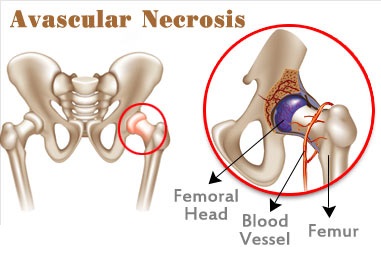Avascular Necrosis Causes, Symptoms, Diagnosis And Treatment

What Is Avascular Necrosis?
Also known as osteonecrosis, avascular necrosis is the death of bone tissue which occurs due to a lack of blood supply.
If the culmination of blood supply is not dealt with, it eventually causes the bone to collapse. This is due to the fact that bone, being a living tissue, requires blood.
If avascular necrosis develops in the bones of a joint, it often leads to destruction of the joint articular surfaces.
Causes Of Avascular Necrosis:
Any of the following causes can lead to the development of avascular necrosis:
- chemotherapy
- alcoholism
- excessivesteroid use
- post trauma
- caisson disease(decompression sickness)
- vascular compression
- hypertension
- vasculitis
- arterial embolism
- thrombosis
- damage from radiation
- sickle cell anemia
- Gaucher’s Disease
- Lupus
- Prolonged, repeated exposure to high pressures (as experienced by commercial and militarydivers). Also known as decompression sickness.
- Autoimmune diseases
- HIV infection
- Chronic corticosteroid use
- Pancreatitis, inflammation of the pancreas
- Joint or bone trauma
- Fatty deposits in blood vessels which block small blood vessels, reducing the blood flow that feeds bones.
Symptoms Of Avascular Necrosis:
No symptoms are exhibited during the initial stages of avascular necrosis.
As the disease progresses, pain is experienced in the affected joint. The pain, initially, is only experienced upon putting weight on the affected joint. Gradually, it progresses onto feeling extreme pain at all times.
The intensity of the pain varies from mild to severe.
Avascular necrosis normally affects the following regions:
- Long bones such as thefemur (the bone extending from the knee joint to the hip joint).
- humerus (the bone of the upper arm),
- knees
- shoulders
- ankles
- jaw
Diagnosis Of Avascular Necrosis:
The following tests and exams are conducted in order to diagnose avascular necrosis:
- Physical exam, where the doctor looks for tenderness in the joints.
- X-rays, which may reveal bone changes which occur in later stages of avascular necrosis
- MRI and CT scans, which show detailed images that can be used to detect early changes in bones
- Bone scan, which highlights the affected parts.
Treatment Of Avascular Necrosis:
The course of the treatment for avascular necrosis is dependent on the following factors:
- Age
- Stage of disease
- Location and extent of bone damage
- Underlying cause
Evaluation of the above mentioned factors showcases which of the following treatment options will be undertaken.
- Medication and Therapy
This treatment option targets the earlier stages of avascular necrosis.
- Nonsteroidal anti-inflammatory drugs
- ibuprofen (Advil, Motrin IB, others)
- naproxen sodium (Aleve, others)
- Osteoporosis drugs.
- alendronate (Fosamax, Binosto)
- Cholesterol-lowering drugs.
- Blood thinners.
- Electrical stimulation.
- Surgical and other procedures
This treatment option targets the later stages of avascular necrosis.
- Core decompression.
- Bone transplant (graft).
- Bone reshaping (osteotomy).
- Joint replacement.
- Regenerative medicine treatment.
By : Natural Health News




